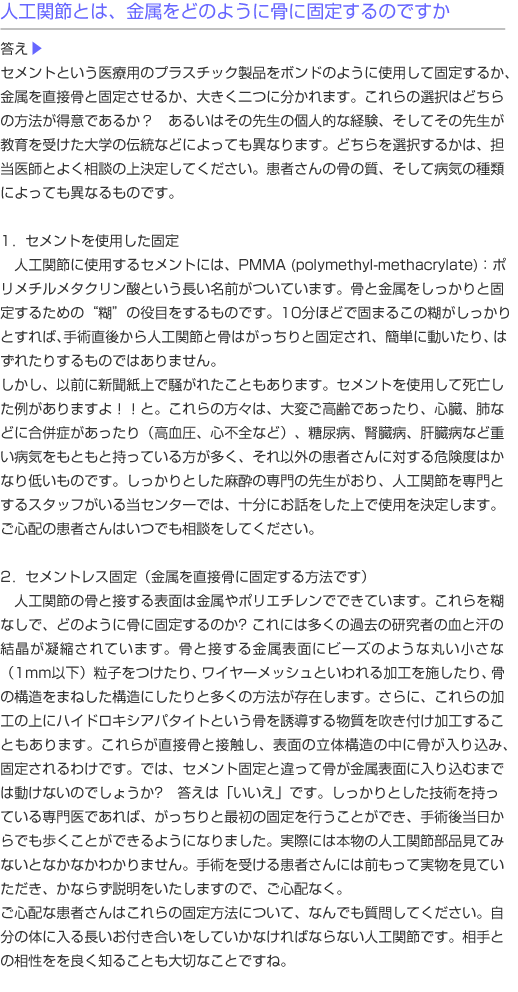


There are generally two methods: one is to use bone cement to bond the metal and the bone and the other is directly place the metal on the bone. Then, which method is better? The choice depends on the surgeonユs experience or medical training background. Please have a thorough consultation with your surgeon and decide which fixation method is more suitable for you. The choice will be determined based on the quality of your bone or your disease kind.
1. Cemented Fixation
The cement used for the artificial joint is called PMMA (polymethyl-methacrylate). It plays a role as glue between bone and metal. When the cement hardens in 10 minutes or so, the artificial joint is firmly fixed to the bone right after the surgery. The artificial joint will not easily get loose or out of position.
In the past, death due to the bone cement once reported in the newspapers caught our attention. Those patients were very elderly or had complications in the lung or the heart such as high blood pressure, heart failure, and diabetes. Or they already had serious problems in the kidney or the liver before the surgery. For those who do not have such health conditions, a risk by the joint replacement surgery is small. Our institution offers specialists in anesthesia and properly-trained operation staff in the joint replacement surgery to give the patient full understanding to determine if the bone cement should be used. Our door is open anytime for any concerns regarding the bone cement.
2. Cement-less Fixation
The surfaces of the artificial joint are made of the metal and the polyethylene. Then, how are these surfaces fixed to the bone without glue? Tremendous efforts and studies have been done by many scientists to enable the metal or the polyethylene to steadily connect to the bone. There are many ways in cement-less fixation; one of them is to use small beads-like particles (smaller than 1 mm) at the articulation surface of the metal. The other way is to utilize a different surface finish called wire mesh. There also is other surface finish type which has the similar structure of the bone. In addition, some devices have hydroxyapatite coating on top of these surface finishes. Hydroxapatite is a substance which induces the bone. These surfaces directly contact the bone and the bone grows into the surface of the metal for the firm fixation. Then, is the patient unable to move until the bone grows into the surface of the device? The answer is メno.モ The joint replacement surgery specialist with good technique gives the patient the firm fixation from the beginning. Therefore, the patient is able to start walking on the surgery day. You do not have to take my word for it; please see for yourself. We offer the patient to observe our patients who had cement-less fixation surgery with guidance at our institution.
It is important for the patient to feel comfortable with the artificial joint because it will be part of the body for a long time. Please do not hesitate to ask us any questions regarding the fixation method
